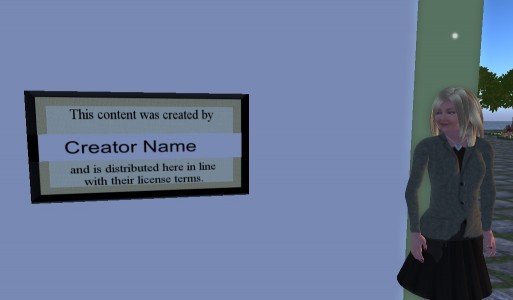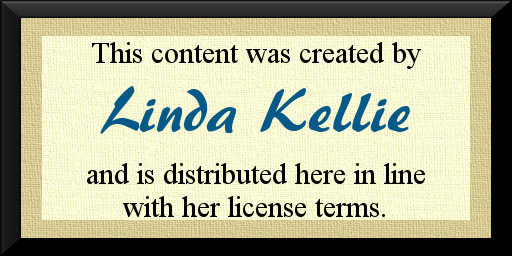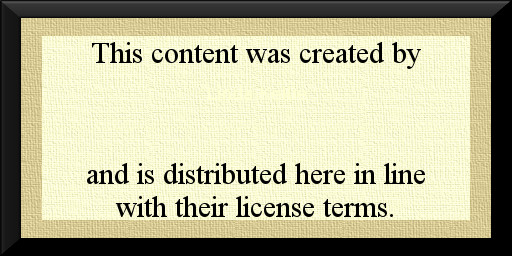Please do this next time you’re in a freebie store on an OpenSim grid.
Look around.
See if you can find a sign up anywhere about the provenance of the freebies.
Is there a sign that says, “Original creations by So-and-So?”
That is an excellent sign.
Are there signs saying, “Linda Kellie Collection” or “OpenSim Creations Collection”?
Those are also good signs.
Provenance
Signs that explain where products are from are called “provenance.”
If there are no signs, check inside individual items themselves. Do their names, descriptions, included note cards, or promotional images explain who made the content?
Ideally, there should be a sign somewhere that says something like, “This content was created by J. Smith and distributed here by permission.”
With Linda Kellie, Ener Hax, and Hypergrid Business content, no permission is needed because the three of us use a public domain license, CC0. An equivalent sign might be “This content was created by Linda Kellie and is distributed here in accordance with her license terms.”
If you’re a store owner, feel free to grab the image below:
Or, if you have a lot of these signs to put up, do what I did and create a sign where you can change the creator’s name by simply typing in a new name in the description field. Get the script here: Simple text from description field. To make it look right, create a cube that’s 1 meter big in the X direction, 0.5 in the Y direction and 0.001 in the Z direction, then set Y Taper to .76. That will create a flat sign with three panels. Put the texture above on the top and bottom pSimple text from description fieldanels, leaving the middle panel blank for the creator name text, and adjust texture sizes to fit. In my case, for the top panel, the horizontal scale was -1, the vertical scale was -0.35, and the vertical offset was 0.30. For the middle panel, the vertical scale was 0.3. For the bottom panel, the vertical scale was 0.43, and the vertical offset was -0.3.

License terms
The second thing to look for in the freebie shop is license terms.
Is the content just for that particular grid? Only for non-commercial use? Only if the creator gets credit?
A good place to include that is in a notecard inside the object.
There have been instances were freebie objects were distributed full-perm by their creators and then showed up on another grid — upsetting the original creators and causing the destination grid to look bad.
By making the license terms as clear as possible, creators can let people know how they want their content to be used.
Some things to watch out for:
- Can the content be taken to other grids? How about to closed, commercial grids?
- Can the content be saved to a local backup?
- Can the content be modified, copied, or passed along to other people? A creator might give away content full-perm so that users can share it between their alts, for example, make changes, or make local backups, but might not want it to be distributed outside the creator’s own freebie store.
- Can the content be sold?
- Does the creator want to get credit for the work?
If the license terms are clear and easy to find, it makes it simple for users to use the content in accordance with the creator’s wishes. And it also makes it simple for the user to decide whether to use this content, or some other content that may be less restrictive.
For example, Linda Kellie allows her content to be used in any way whatsoever, including commercial, including without giving her credit. That makes it very easy for people to use her content — they don’t have to worry about accidentally violating a rule — and has helped contribute to the wide use of her creations.
Many people, including many contributors to OpenSim Creations, use the Creative Commons license system.
Here are the most popular licenses:
- CCO — The content can be used in any way at all, no attribution necessary. Also known as the “public domain” license.
- CC-BY — The original creator must get credit for the work.
- CC-NC — The content cannot be used for commercial purposes. This is not particularly clear for OpenSim — is it okay for a company to use the content internally? Is it okay for a commercial grid to distribute the content as a freebie? If you don’t want commercial uses, spell out exactly what you mean in a notecard.
- CC-BY-NC — A combination of the above two licenses. The creator wants to get credit, and doesn’t want to see their work used commercially.
Why it matters
There are two main reasons why you should care about what freebie stores do.
First, is plain old self-protection. You don’t want to have a creator or the creator’s friend stumble across your build, or a picture of your build, see their content used in an unapproved way, and make a giant stink about it. Trust me, the bad taste in your mouth never goes away. Plus, they can file complaints and get your store, your region, or even your entire grid taken down, and, if the infringement is severe enough, take you to court.
Is that little freebie chair or freebie hair or whatever it is worth the hassle? No, no it is not.
Second, is to protect the flow of content.
I recently heard from a very prolific creator who wasn’t distributing his content in OpenSim because he kept seeing it pop up in freebie stores without his permission.
Sure, the source of most illegal content is Second Life. Not distributing content in OpenSim means that good, honest customers won’t be able to get your content, while the crooks get the market all to themselves.
It all comes back to that “bad taste in your mouth” issue. When creators see their content being used in ways they don’t want, it sours them on OpenSim. It sends the message that we don’t care about the creators. That we’re selfish and short-sighted people, who want our free stuff now, and aren’t worried about the future of the platform.
Of course, most people aren’t like that. We will happily get the movie on Netflix and the song on iTunes. We’d rather have our content in a convenient, legal form than hunt around for it and get exposed to viruses, trojans, and risk of legal action.
Unfortunately, honest people are often shy. They don’t speak up when they see something wrong. They hope that someone else takes care of it.
Speak up!
Drop a polite note to the store owner. Something like the following:
I love your store and would love to use this content in my build, but I want to make sure I don’t run afoul of creators’ wishes. Could you please post the provenance and the license terms for this content? Thank you very much!
Send a copy of the note to the grid owners. Grid owners care about this stuff because they’re the ones who are going to get sued if there’s content infringement on their grid, and grids are typically run on shoestring budgets. Nobody wants to get saddled with hefty legal fees.
- International singers gather on Alternate Metaverse Grid for first annual International Day - April 15, 2024
- OpenSim hits new land, user highs - April 15, 2024
- Wolf Territories rolls out speech-to-text to help the hearing impaired - April 15, 2024


